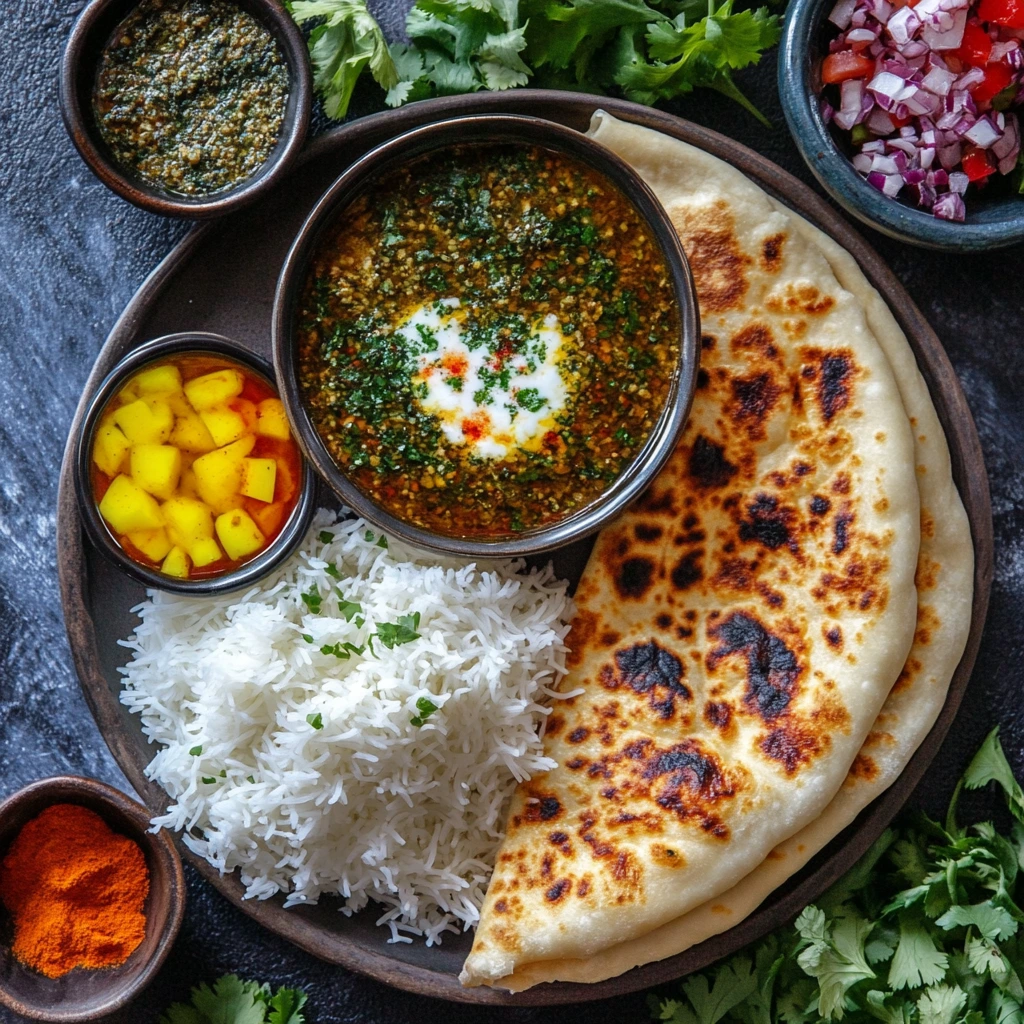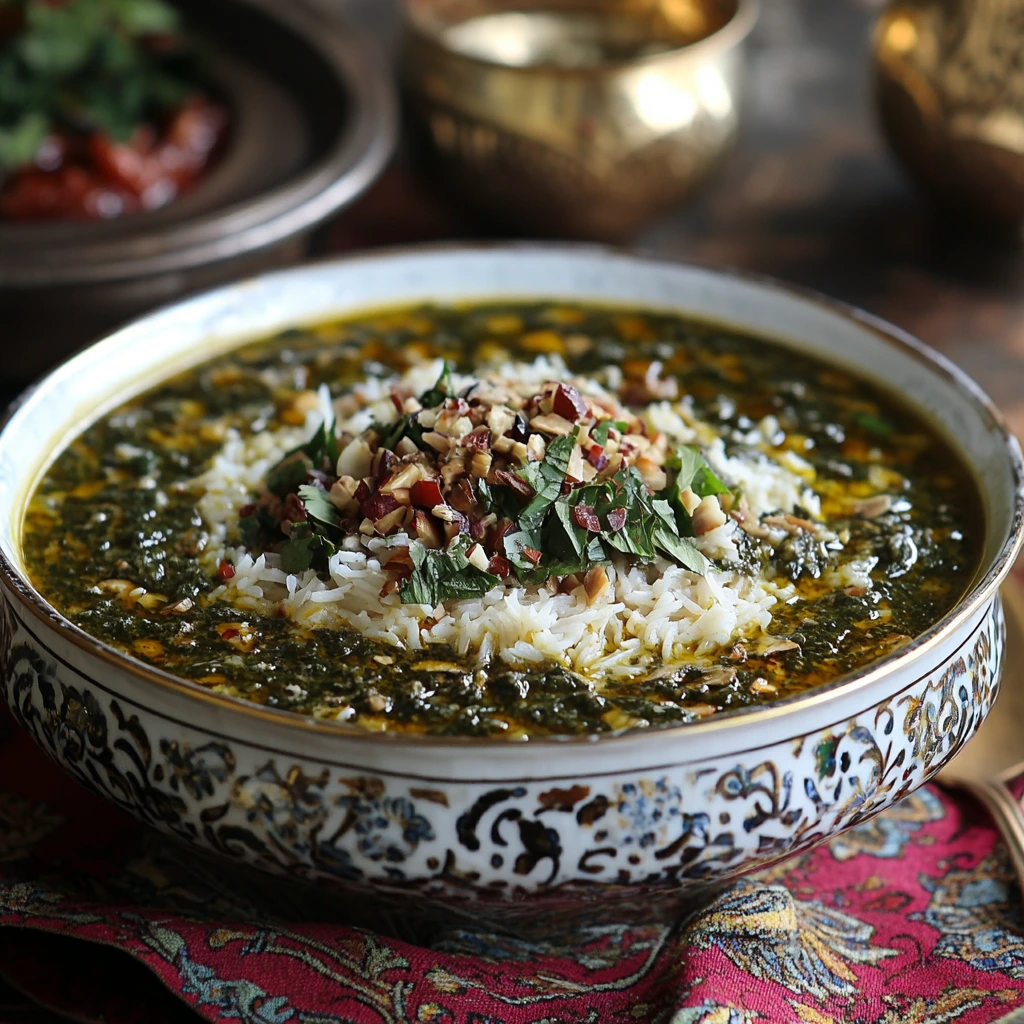Fesenjan, a dish that embodies the heart and soul of Persian cuisine, is a rich, flavorful stew that has stood the test of time. Often regarded as one of Iran’s most cherished dishes, Fesenjan is a perfect blend of complexity and comfort, featuring a luscious sauce made from ground walnuts and tangy pomegranate molasses. The beauty of Fesenjan lies in its balance—its deep, earthy flavors are complemented by a subtle sweetness that perfectly marries with the tenderness of chicken or duck. This dish is more than just a meal; it’s a cultural experience, one that has been enjoyed across generations in Persian households, often served at special gatherings and celebrations.
What makes Fesenjan truly unique is its ability to merge the savory and sweet in a way that feels completely harmonious. The slow-cooked walnuts create a creamy texture, while the pomegranate molasses adds a vibrant tartness that makes every bite unforgettable. Whether you’re already familiar with Persian food or are looking to try something new and exciting, this dish will transport your taste buds to the rich, aromatic flavors of Iran. In this article, we will walk you through the best Fesenjan recipe, with tips and tricks to ensure that your stew turns out perfectly every time. Get ready to cook up a dish that’s as rich in history as it is in flavor.

The Best Fesenjan Persian Recipe – Rich, Nutty & Sweet
Fesenjan is not just a dish; it’s a symbol of Persian culture, steeped in history and tradition. As one of the most beloved and celebrated recipes in Iran, Fesenjan offers a unique glimpse into the culinary art of the Persian people. This luxurious stew, rich in flavor and texture, is a perfect blend of savory, sweet, and sour—qualities that reflect the sophisticated palate of Persian cuisine. With its origins rooted in ancient Persia, Fesenjan has been passed down through generations, evolving over time while staying true to its core ingredients and its deep cultural significance.
The history of Fesenjan dates back to the times of the Persian Empire, where it was often considered a royal dish, reserved for special occasions and feasts. The dish’s complex flavors, combining the earthiness of ground walnuts with the tart sweetness of pomegranate molasses, were considered a perfect balance of taste, representing the delicate harmony that Persian cooking is known for. Its origins are closely tied to the region’s agricultural products—walnuts and pomegranates—which have been cultivated for centuries in Iran’s fertile lands. The combination of these ingredients, along with slow-cooked meat, results in a stew that is both hearty and luxurious, perfect for a festive gathering or family meal.
Fesenjan is more than just food; it’s an experience, a dish that tells a story of Persian hospitality and generosity. In traditional Iranian homes, it’s often served at important family gatherings, including weddings, religious holidays like Nowruz (the Persian New Year), and other celebrations that mark significant milestones. The preparation of Fesenjan is often a communal activity, with multiple generations coming together to prepare the dish, making it a time to bond and share in the joy of cooking and eating. It’s a dish that requires patience and attention to detail, as it’s all about achieving the perfect balance of flavors—rich, nutty, tart, and sweet—which is the hallmark of Persian cuisine.
What makes Fesenjan truly special is its versatility. While the classic version uses chicken or duck as the main protein, the recipe can easily be adapted with other meats such as lamb or beef. This flexibility allows the dish to be enjoyed in a variety of contexts, from an intimate family meal to a grand banquet. The walnuts create a thick, creamy sauce that coats the meat, while the pomegranate molasses adds a distinctive tangy sweetness that brightens the dish and complements the richness of the meat. The stew is traditionally served with fluffy, fragrant Persian rice, which helps to balance the richness of the sauce.
The key to making the perfect Fesenjan lies in the slow cooking process. Patience is essential, as the flavors need time to meld together, and the sauce must thicken to a velvety consistency. The slow cooking process also allows the walnuts to release their natural oils, enriching the sauce and deepening its flavor. Whether served on a special occasion or enjoyed as a comforting meal at home, Fesenjan evokes a sense of warmth and community, drawing people together to share in a meal that is as rich in flavor as it is in tradition.
For many Iranians, Fesenjan is more than just a dish—it’s a connection to their heritage, a celebration of the land’s bounty, and a reminder of the importance of family and tradition. When you make Fesenjan, you’re not just cooking; you’re participating in a centuries-old culinary practice that has brought joy and comfort to countless generations. Whether you’re making it for a special event or simply to enjoy the deep flavors of Persian cuisine, Fesenjan offers a taste of Iran’s rich cultural history, and it’s a dish that will surely leave a lasting impression on anyone who tries it.

Key Ingredients for the Perfect Fesenjan
The magic of Fesenjan lies in its key ingredients, which come together to create a dish that is both rich in texture and layered with complex flavors. Each element plays a crucial role in achieving the perfect balance of sweet, savory, and tangy notes that make this Persian stew so unique. Let’s take a closer look at the essential ingredients that bring Fesenjan to life:
Ground Walnuts – The Heart of the Sauce
Ground walnuts are the backbone of the Fesenjan sauce, providing a rich, creamy texture that’s crucial for the dish’s signature depth. When ground and cooked slowly, walnuts release their natural oils, giving the sauce its luxurious consistency. The flavor of the walnuts is nutty and slightly earthy, acting as the perfect counterpoint to the tartness of the pomegranate molasses. In traditional Fesenjan recipes, walnuts are toasted to intensify their flavor before being ground into a fine powder. The quality of the walnuts is important, as fresh, high-quality walnuts will provide a much smoother and more aromatic sauce. If you can, use unsalted walnuts to control the seasoning of the dish.
Pomegranate Molasses – The Tangy Sweetness
Pomegranate molasses is another star ingredient in Fesenjan. This thick, syrupy concentrate of pomegranate juice adds both sweetness and tanginess to the dish, balancing the richness of the walnuts. Pomegranate molasses is a pantry staple in Persian cooking, used to add depth and complexity to a variety of dishes, from stews to salad dressings. It’s made by simmering fresh pomegranate juice down to a thick syrup, resulting in a slightly tart, fruity sweetness that plays an essential role in the flavor profile of Fesenjan. It’s what makes the stew’s sauce both savory and sweet in a way that no other ingredient could replicate. If you can’t find pomegranate molasses, you can make a substitute at home by reducing pomegranate juice with sugar and lemon, although the authentic flavor may vary.
Chicken or Duck – The Perfect Protein
While Fesenjan can be made with a variety of meats, chicken and duck are the most traditional and popular choices. Chicken, with its mild flavor, soaks up the rich walnut and pomegranate sauce, while duck offers a more robust, gamey flavor that pairs beautifully with the sweetness of the pomegranate molasses. Duck is often preferred for special occasions because of its richness, but chicken is a more common and practical option for everyday cooking. Both meats, when slow-cooked in the stew, become tender and absorb the sauce’s flavors, making each bite irresistibly juicy and full of flavor. The choice between chicken and duck depends on personal preference, but both will yield a delicious result.
Onions – A Flavor Base
Like many Persian stews, Fesenjan starts with sautéed onions as its flavor base. Onions provide a subtle sweetness and depth to the dish, and when caramelized, they help create a richer, more complex flavor profile. The onions also help to build the foundation for the stew’s sauce, ensuring that the walnuts and pomegranate molasses have a balanced backdrop to work with. It’s important to sauté the onions slowly over medium heat until they’re golden and softened, as this brings out their natural sweetness and enhances the overall flavor of the stew.
Spices – Adding Depth and Warmth
While Fesenjan doesn’t rely heavily on spices, a few key additions are essential to deepen the flavor and elevate the overall dish. Common spices in Fesenjan include:
- Cinnamon: A warm, aromatic spice that adds a hint of sweetness and complexity to the stew.
- Turmeric: Known for its earthy, slightly bitter flavor, turmeric adds a warm golden hue to the dish and enhances its depth.
- Saffron: Although optional, saffron is often added to Fesenjan to impart a luxurious fragrance and a subtle, floral note that pairs wonderfully with the other ingredients. A pinch of saffron threads steeped in hot water will give the dish its characteristic vibrant color and delicate taste.
Salt and Pepper – Essential Seasoning
Like any dish, proper seasoning is key to bringing the flavors together. Salt and black pepper help balance the sweetness of the pomegranate molasses and the richness of the walnuts, while also enhancing the natural flavors of the meat. It’s essential to taste and adjust the seasoning as the stew cooks, ensuring that all the flavors are perfectly balanced.
These are the foundational ingredients that define Fesenjan. Each one contributes to the stew’s distinct flavor and texture, creating a harmonious blend that is unique to Persian cuisine. When making Fesenjan, it’s important to choose the freshest, highest-quality ingredients you can find, as they will ensure that your stew turns out as rich and flavorful as intended. Whether you stick to the classic chicken version or opt for duck, these key ingredients will transform your dish into an unforgettable culinary experience.

Step-by-Step Guide to Making the Best Fesenjan
Making the perfect Fesenjan requires patience and attention to detail, but the results are well worth the effort. With the right ingredients and a bit of time, you can create a dish that is rich, flavorful, and unforgettable. Follow this step-by-step guide to ensure that your Fesenjan turns out perfectly every time.
Step 1: Prepare the Ingredients
Before you start cooking, it’s important to prepare all your ingredients. Proper preparation ensures a smooth cooking process and helps the flavors come together seamlessly.
- Grind the Walnuts: Start by grinding your walnuts. You want a fine, powdery texture, so use a food processor or a spice grinder to achieve this. If you prefer a chunkier texture, you can leave the walnuts slightly coarse, but a smooth, creamy consistency is preferred for Fesenjan. Toast the ground walnuts in a dry skillet over low heat until they release their oils and become fragrant. This will enhance their flavor and help thicken the sauce later.
- Prepare the Meat: If you’re using chicken, cut it into pieces (preferably bone-in for more flavor) or leave it whole. For duck, use whole ducks or duck legs for a richer, more tender stew. Season the meat with salt, pepper, and a pinch of turmeric.
- Chop the Onion: Finely chop one large onion, which will form the base of your stew. The onion should be sautéed until golden brown, releasing its sweetness and enhancing the overall depth of flavor in the dish.
- Soak the Saffron (optional): If you’re using saffron, soak a pinch of saffron threads in a tablespoon of hot water to release its vibrant color and delicate fragrance.
Step 2: Sauté the Onion and Brown the Meat
The cooking process begins by building flavor with the onion and meat.
- Sauté the Onion: Heat a large pot or Dutch oven over medium heat and add a few tablespoons of oil. Once the oil is hot, add the chopped onions and sauté until they become golden brown and caramelized, about 10-15 minutes. This step is essential for adding sweetness and depth to the base of the stew.
- Brown the Meat: Once the onions are caramelized, add your chicken or duck pieces to the pot. Sear the meat on all sides until browned. This will develop a rich, flavorful crust on the meat, which will later infuse the stew with even more depth.
Step 3: Build the Sauce
Now it’s time to create the sauce that will define your Fesenjan.
- Add the Ground Walnuts: Once the meat is browned, add the ground walnuts to the pot. Stir the walnuts into the onions and meat, letting them toast slightly in the oil for 1-2 minutes. This will help release the walnut oils, making the sauce creamy and thick.
- Add the Pomegranate Molasses: Pour in the pomegranate molasses, stirring to combine. This will provide the perfect balance of tangy sweetness that is characteristic of Fesenjan. If the molasses is too thick, you can thin it with a bit of water or chicken broth. Stir everything together, ensuring that the walnuts and molasses are evenly distributed.
- Add the Spices: Sprinkle in your cinnamon, turmeric, and any other spices you’re using (such as saffron if you’re including it). Stir well to ensure the spices are fully incorporated into the sauce. The spices will add warmth and complexity to the dish, complementing the sweetness of the pomegranate molasses and the earthiness of the walnuts.
Step 4: Add Liquid and Simmer
With the sauce in place, it’s time to add the liquid and allow the stew to slow-cook, allowing the flavors to meld together.
- Add Water or Stock: Pour in enough water or chicken broth to cover the meat by about 1-2 inches. Stir to combine and ensure that the ingredients are well distributed in the pot. The liquid will help dissolve the ground walnuts and create a thick, velvety sauce.
- Bring to a Boil: Turn the heat to high and bring the liquid to a boil. Once it reaches a boil, lower the heat to a simmer. You want to cook the stew over low heat for about 1.5 to 2 hours, stirring occasionally. During this time, the sauce will thicken, and the meat will become incredibly tender as it absorbs the rich, flavorful sauce.
- Skim the Fat: As the stew simmers, you may notice some fat floating on the surface, especially if you’re using duck. Skim off the excess fat as needed to maintain a balanced flavor.
Step 5: Adjust Seasoning and Simmer Until Perfect
After the stew has simmered for the recommended time, it’s time to taste and adjust the seasoning.
- Taste and Season: Taste the stew for balance. If the flavor is too sweet, add a bit more salt or a dash of lemon juice to brighten it. If it’s too tart, add a bit more pomegranate molasses or sugar to mellow it out. Adjust the seasonings to your personal preference, remembering that Fesenjan should have a perfect balance of savory, sweet, and tangy.
- Simmer to Desired Consistency: Allow the stew to simmer until the sauce reaches the consistency you desire. If it’s too thick, add more liquid (water or broth); if it’s too thin, let it reduce for a few more minutes.
Step 6: Serve and Enjoy
Once your Fesenjan is ready, it’s time to serve!
- Serving: Fesenjan is traditionally served with fluffy Persian rice (known as “polo”), but you can also pair it with flatbread or roasted vegetables. The richness of the stew pairs wonderfully with the delicate flavor of the rice, which helps balance the strong flavors in the dish.
- Garnishing: Garnish the Fesenjan with a sprinkle of fresh herbs like parsley or pomegranate seeds for a pop of color and freshness. The pomegranate seeds also enhance the dish with an additional burst of tangy sweetness, making each bite more enjoyable.
- Serving Suggestions: Fesenjan is often enjoyed as the centerpiece of a larger Persian feast, surrounded by a variety of other dishes. It’s perfect for family gatherings, special occasions, or a cozy dinner with loved ones.

Tips & Tricks for Perfecting Your Fesenjan
Fesenjan is a dish that benefits from time, patience, and attention to detail. While the recipe itself is straightforward, there are a few key tips and tricks that can elevate your Fesenjan to the next level. Whether you’re making this dish for the first time or looking to perfect your technique, these tips will help ensure that every bite is rich, balanced, and full of flavor.
1. Choose High-Quality Walnuts
The quality of walnuts used in Fesenjan has a significant impact on the flavor and texture of the dish. Fresh, high-quality walnuts release their oils and flavors more effectively, making the sauce rich and creamy. Look for unsalted, raw walnuts to control the level of salt in your dish. If possible, buy walnuts in their shells and crack them yourself to ensure freshness. Fresh walnuts also have a more delicate, less bitter taste, which is essential for achieving the perfect balance of flavors in the stew.
2. Toast the Walnuts for Extra Flavor
To bring out the full flavor of the walnuts, always toast them before grinding. Toasting the ground walnuts in a dry skillet over low heat helps to release their natural oils, which enhances the nuttiness and gives the sauce a smoother, creamier texture. Be careful not to over-toast the walnuts, as this can make them bitter. A light toast for 3-5 minutes is ideal. Let them cool before grinding to preserve their flavor.
3. Balance the Sweet and Sour with Precision
The balance between the sweet and sour elements of Fesenjan is crucial to achieving the perfect flavor profile. Pomegranate molasses is naturally tangy and sweet, but it’s essential to adjust the quantity based on your preference. If you prefer a sweeter Fesenjan, you can add a little more molasses or even a bit of sugar. Conversely, if you find the stew too sweet, you can brighten the flavors by adding a splash of lemon juice or a bit of vinegar to increase the acidity. Always taste the sauce as it simmers, and adjust the balance of sweet and sour until it feels just right.
4. Slow Cook for Depth of Flavor
Fesenjan requires slow cooking to allow the flavors to develop fully. Don’t rush the process. Cooking the stew over low heat for 1.5 to 2 hours (or longer if you have time) ensures that the walnuts release their oils and the sauce thickens to a velvety consistency. The slow simmer also helps tenderize the meat, allowing it to absorb the rich sauce. Be patient, and resist the urge to increase the heat to speed up the cooking time. Low and slow is the way to go!
5. Don’t Skip the Sautéing Step for Onions
The onions form the base of the dish, and their caramelization is essential for building depth of flavor. Take the time to sauté the onions until they’re golden and softened, as this enhances their natural sweetness and allows them to blend seamlessly into the sauce. Don’t rush this step—caramelized onions add a subtle sweetness and umami flavor to the stew, providing a rich backdrop for the walnuts and pomegranate molasses.
6. Use Bone-In Meat for Extra Flavor
While boneless chicken or duck can certainly be used, bone-in meat (such as chicken thighs or duck legs) produces a richer, more flavorful stew. The bones contribute to the depth of the sauce and help infuse the stew with additional richness. If you prefer boneless meat, you can still achieve a delicious result, but bone-in meat is highly recommended for the best flavor.
7. Skim Off Excess Fat
Fesenjan, especially when made with duck, can release quite a bit of fat during the cooking process. Skimming off the fat as it cooks helps to prevent the stew from becoming overly greasy and allows the flavors to shine through. If you don’t mind a bit of richness, you can leave some of the fat in the stew, but excessive fat can overwhelm the delicate balance of flavors. Use a spoon or a fat separator to skim off the excess fat periodically.
8. Add Fresh Herbs and Pomegranate Seeds for Garnish
While Fesenjan is already rich and flavorful on its own, a sprinkle of fresh herbs and pomegranate seeds can elevate the dish even further. Fresh herbs like parsley, cilantro, or mint provide a burst of color and freshness, which contrasts beautifully with the richness of the stew. Pomegranate seeds not only add a pop of color but also bring an extra layer of sweetness and tartness that complements the flavors of the dish. Garnishing just before serving will add texture and a fresh contrast to the velvety sauce.
9. Let It Rest Before Serving
Like many stews, Fesenjan benefits from resting for 10-15 minutes before serving. This allows the flavors to settle and meld together, making the dish even more delicious. If you have time, you can even make Fesenjan a day ahead. The flavors often improve after sitting overnight in the fridge, giving the stew even more depth and complexity.
10. Pair with the Perfect Side Dishes
Fesenjan is typically served with fluffy Persian rice (polo), but it also pairs wonderfully with other sides. Persian rice, with its delicate flavor and slightly crispy bottom (tahdig), helps balance the richness of the stew. You can also serve Fesenjan with flatbread or roasted vegetables like eggplant or squash. A simple cucumber and yogurt salad (mast-o-khiar) can also add a refreshing contrast to the warm, hearty stew.
11. Experiment with Variations
While the classic version of Fesenjan is made with chicken or duck, don’t be afraid to experiment with other meats. Lamb, beef, or even vegetarian versions using tofu or tempeh can all be delicious alternatives. If you’re trying a vegetarian Fesenjan, you may want to add extra spices or vegetables to compensate for the richness that meat typically provides.
hh
Fesenjan is much more than just a delicious dish—it’s a true showstopper that’s perfect for any special occasion or gathering. Whether you’re hosting a festive dinner, celebrating a holiday, or enjoying a family reunion, Fesenjan brings people together with its rich flavors, impressive presentation, and the warm hospitality that it represents. Here’s why this traditional Persian dish is such a crowd-pleaser and why it’s an ideal choice for your next celebration.
1. Rich, Complex Flavors That Appeal to All Palates
One of the reasons Fesenjan is so beloved is its exceptional balance of flavors. The nutty richness of the ground walnuts, the sweet tartness of pomegranate molasses, and the tender, juicy meat come together in a symphony of taste that appeals to a wide variety of palates. It’s a dish that satisfies both those who enjoy savory, hearty meals and those who appreciate a touch of sweetness. The complexity of the flavor profile is what makes Fesenjan so appealing to different guests—whether they’re familiar with Persian cuisine or new to it, everyone will appreciate the depth of flavor.
The versatility of Fesenjan is another factor that makes it so popular. While the classic version uses chicken or duck, it can easily be adapted to suit dietary preferences, such as lamb or even a vegetarian version using tofu or tempeh. This adaptability ensures that Fesenjan can be enjoyed by a wide range of guests, including those with dietary restrictions.
2. Visually Stunning and Impressive
Not only is Fesenjan delicious, but it also looks stunning on the table, making it the perfect centerpiece for any special meal. The deep, rich colors of the stew, especially when paired with vibrant garnishes like fresh herbs and pomegranate seeds, make it visually striking. The glossy, velvety sauce enveloping the meat, along with the contrasting red and green garnishes, provides a feast for the eyes as much as it does for the palate.
If you’re hosting a dinner party or a family celebration, Fesenjan is sure to impress your guests with its beauty and elegance. The fact that it is a Persian dish, rooted in centuries of tradition, also adds an element of cultural sophistication to the meal, making it feel even more special.
3. Perfect for Sharing and Family-Style Dining
Fesenjan is a stew that is meant to be shared. It’s served in large pots or platters, making it the perfect choice for family-style dining, where everyone can gather around and serve themselves. This communal style of eating is an integral part of Persian culture, where sharing meals brings people together and fosters a sense of connection. The rich, aromatic stew is often paired with fluffy Persian rice (polo) or flatbread, making it easy for guests to serve themselves and enjoy a hearty meal together.
Because it’s such a filling dish, Fesenjan can easily serve a large number of people, which makes it an ideal choice for big gatherings, holidays, or celebrations. Whether you’re serving a small group of friends or a large family, this dish allows everyone to indulge in the same comforting, delicious experience. It encourages conversations, laughter, and a sense of warmth that is perfect for any special occasion.
4. A Dish That Can Be Made Ahead
One of the key reasons Fesenjan is so great for special occasions is that it can be made ahead of time. In fact, Fesenjan often tastes even better the next day as the flavors continue to develop and meld together overnight. This makes it an excellent dish for busy hosts who want to minimize the time spent in the kitchen on the day of the event.
Prepare the dish the day before your gathering, and simply reheat it on the stovetop or in the oven. The stew will maintain its flavor and texture, allowing you to focus on other parts of your event, whether that’s preparing sides, setting the table, or enjoying time with your guests.
5. An Aromatic Experience for the Senses
The cooking process of Fesenjan itself is an aromatic experience that fills the house with mouthwatering scents. As the stew simmers, the fragrance of toasted walnuts, cinnamon, turmeric, and saffron (if used) will create an irresistible aroma that will have your guests eagerly anticipating the meal. This sensory experience adds an extra layer of enjoyment to the dish, making Fesenjan even more memorable for those who experience it.
6. A Taste of Persian Tradition
Fesenjan carries with it a sense of history and tradition. It’s a dish that has been passed down through generations, often served on special occasions such as weddings, religious holidays like Nowruz (the Persian New Year), and family gatherings. When you serve Fesenjan, you’re not only offering a delicious meal but also inviting your guests to experience a piece of Persian culture and hospitality. It’s a wonderful way to share the culinary richness of Iran and introduce others to the flavors and traditions that have been cherished for centuries.
7. Great for Special Celebrations and Holidays
Given its association with important celebrations and holidays in Persian culture, Fesenjan is an excellent choice for your own special occasions. Whether it’s a birthday, anniversary, holiday dinner, or a milestone event, this dish adds a celebratory touch to any table. It’s often served during the Persian New Year (Nowruz), weddings, or family reunions—occasions where people come together to celebrate love, joy, and tradition.
Its luxurious flavors and rich texture make it feel like a special treat, perfect for marking memorable moments. Serving Fesenjan at your next celebration will create lasting memories and provide an unforgettable experience for your guests.
Fesenjan’s combination of flavor, presentation, and cultural significance makes it an ideal dish for any special occasion. It’s a crowd-pleaser because it’s not only delicious but also creates an experience—a meal that brings people together, fosters conversation, and celebrates the joy of food. So, whether you’re preparing for a holiday gathering or hosting a dinner party, Fesenjan is the perfect dish to serve and share with those you love.
Table of Contents
Vanilla Bean Paste Recipe: The Secret to Rich, Flavorful Desserts – labelrecipes.com


Very good https://is.gd/tpjNyL
thank you